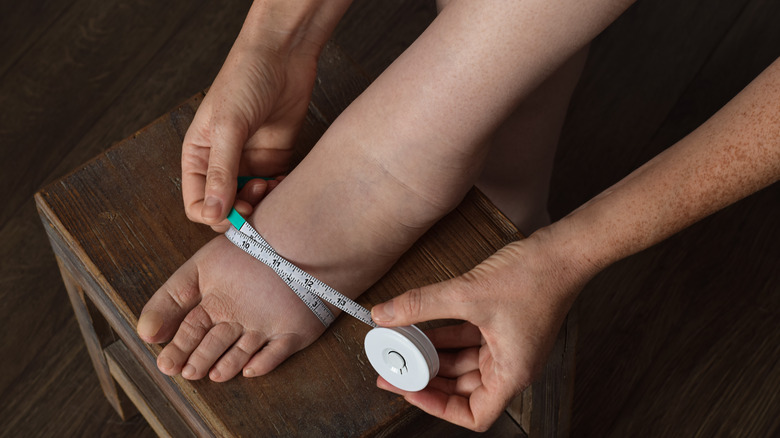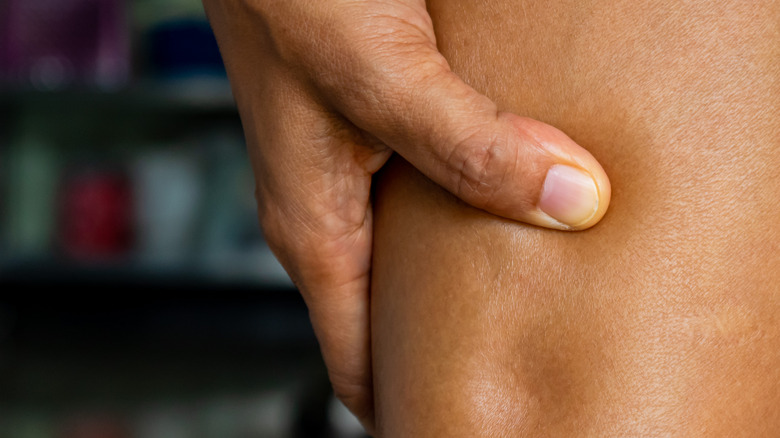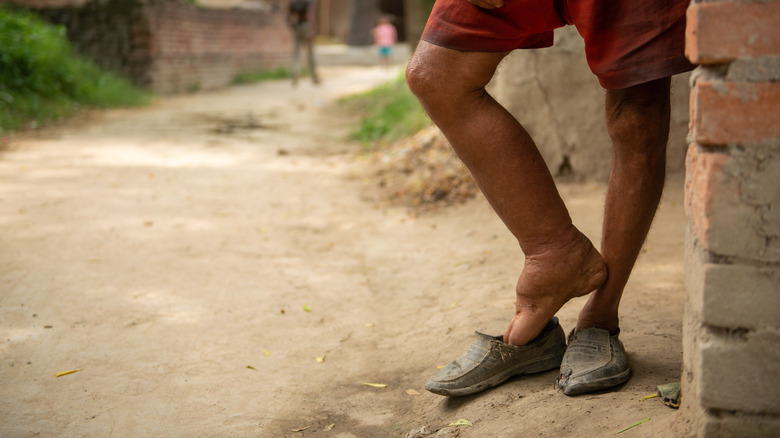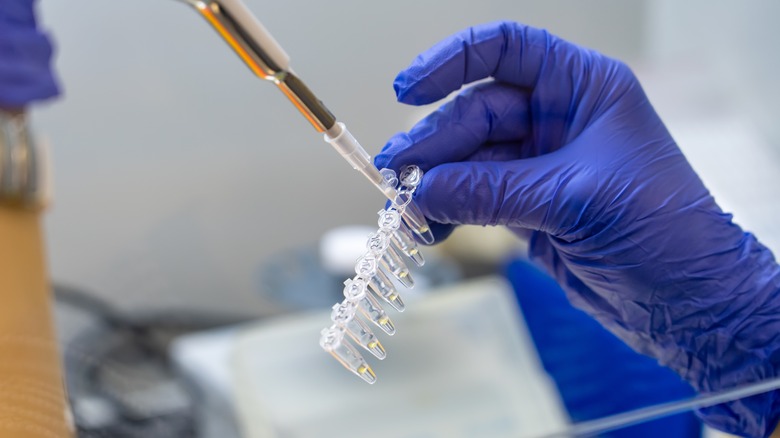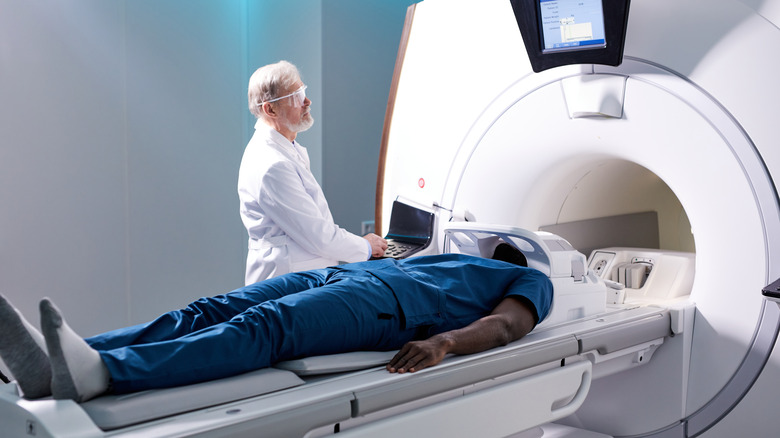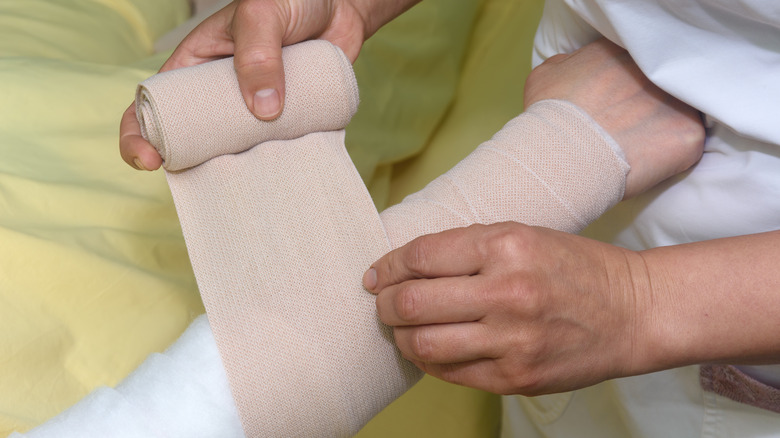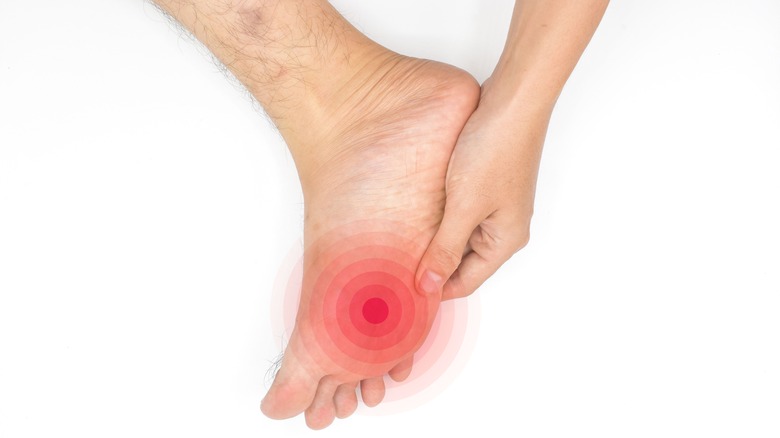Lymphedema Explained: Causes, Symptoms, And Treatments
Lymphedema is a chronic disease that causes swelling in various parts of the body (per the Cleveland Clinic). It is a type of edema that occurs when there is an underlying problem with the lymphatic system, otherwise known as the system that's responsible for collecting excess fluid from your tissues. When the lymphatic system doesn't function as it should, fluid can begin to accumulate in various parts of the body, resulting in swelling.
Lymphedema can be broken down into primary and secondary subtypes (via StatPearls). Primary lymphedema, sometimes referred to as hereditary lymphedema, is rare and affects an estimated one in 100,000 individuals in the United States. This type of lymphedema is due to either an inherited or congenital malformation of the lymphatic system. Secondary lymphedema is much more common. It affects an estimated one in 1,000 individuals in the U.S. and is caused by injuries or obstruction of the lymphatic system. Some of the more common causes of secondary lymphedema include parasitic infections and complications arising from cancer treatment.
Swelling caused by lymphedema can occur anywhere in the body, although it's most common in the arms and legs. The most apparent signs and symptoms associated with lymphedema include swelling, restricted range of motion, pain, altered sensation, and changes to the overlying skin of an affected limb or body part. Lymphedema has no cure and requires lifetime routine physical and occupational therapy.
In this article, we'll take a deeper look into the causes, symptoms, and treatment options for lymphedema.
Basics of edema
In the simplest terms, edema is swelling or puffiness present in certain parts of the body (per American Family Physician). Edema occurs when either too much fluid leaves the vascular space (arteries and veins) or when not enough fluid makes its way out of the tissues (via StatPearls). This fluid can accumulate and cause the affected region to swell.
Edema can affect almost any part of the body. For example, inflammation following an insect bite can lead to a small area of edema. A more extreme example of edema can be seen in some patients with severe kidney disease, where you can have swelling of the entire body (also known as anasarca).
According to WebMD, there are several classifications of edema. Peripheral edema, pedal edema, and lymphedema are types of edema that affect the extremities. Peripheral edema, most commonly seen in the legs, feet, ankles, and arms, is often associated with problems arising from the circulatory system, lymph nodes, or kidneys. Pedal edema occurs in the feet and lower legs, and is linked with old age and pregnancy. Lymphedema often results from damage to the lymphatic system.
Other types of edema can include pulmonary edema (build-up of fluid in the lungs), cerebral edema (fluid accumulation in the brain), and macular edema (fluid build-up in the eye).
While there are a number of conditions that may result in edema, such as a sprained ankle, bee sting, or skin infection, there are also several other causes that may result from serious underlying conditions. These include allergic reactions, heart failure, critical illness, obstruction of (fluid) flow, liver disease, kidney disease, head trauma, and a number of medications.
The lymphatic system maintains a proper balance of fluids in the tissues
According to the Cleveland Clinic, the lymphatic system is "a network of tissues, vessels, and organs that work together to move a colorless, watery fluid called lymph back into your circulatory system (your bloodstream)."
There are two major functions of the lymphatic system (per Biology Dictionary). The most well known is to carry pathogens (bacteria, viruses, fungi) from different parts of the body to the lymph nodes. Another function carried out by the lymphatic system is to maintain a proper balance of fluid between the tissues and bloodstream.
The blood in the circulation is under constant pressure (via BetterHealth). The body takes advantage of this pressure and uses it to push nutrients, fluids, and immune cells into the tissues. This allows all of the body's tissues to have the necessary food, oxygen, and protection they need in order to survive. What's left behind gets removed by the lymphatic system.
Of the 20 liters of plasma that flow through your circulatory system every day. "However, the lymphatic system processes nearly 20% of this fluid, which escapes from capillaries and cells" (via Biology Dictionary). Before this fluid can cause edema, it is normally returned to the circulation through the help of the lymphatic system.
Lymphedema can be a complication of cancer treatment
According to the National Cancer Institute, lymphedema can result from damage to the lymphatic system following procedures that are commonly used in the treatment of many types of cancer.
One such procedure is the surgical removal of lymph nodes. During this type of procedure, lymph nodes that may be at risk of harboring cancerous cells are surgically removed (per Johns Hopkins Medicine). This procedure can inadvertently disrupt the flow of lymphatic fluid, and can place a patient at risk of developing lymphedema.
Another procedure that can damage the lymphatic system and increase the likelihood of later developing lymphedema is radiation therapy. In the treatment of breast cancer for example, some or all of the axillary lymph nodes (lymph nodes under the arm) are treated with radiation. While this is important in killing the underlying cancer cells, it can lead to unwanted scarring and blockages of the lymphatic system.
Lymphedema following lymph node dissection or radiation therapy can occur at any time following the procedure. "The most common type of lymphedema is painless and may slowly develop 18 to 24 months or more after surgery. It does not get better without treatment" (via Johns Hopkins Medicine).
However, it's also possible for patients to develop lymphedema within just a few days after the procedure.
While there is no way to know exactly who will and won't develop lymphedema, doctors may sometimes recommend newer types of lymph node surgeries that have a lower risk.
Lymphedema can be caused by a parasite
According to StatPearls, the most common cause of lymphedema worldwide is lymphatic filariasis. This disease is caused by infection with the parasitic worm Wuchereria bancrofti, which resides in the human lymphatic system (per the Centers for Disease Control and Prevention).
Lymphatic filariasis is commonly seen in the developing world and affects more than 120 million people in 72 different countries across Asia, Africa, the Western Pacific, as well as in parts of the Caribbean and South America (via the World Health Organization). Lymphatic filariasis is spread from person-to-person through the bites of infected mosquitos. Microscopic larvae from this parasite make their way through the skin and into a host's lymphatic system, where they can then cause inflammation and damage to the lymphatic vessels.
While the majority of people with lymphatic filariasis are asymptomatic, many cases result in lymphedema. Without treatment, this type of lymphedema can progresses to a more advanced condition known as elephantiasis. According to the National Organization for Rare Disorders, elephantiasis causes swelling of an entire arm or leg to several times its normal size. The extremity may also show signs of ulcerated and darkened skin (hyperkeratosis).
Treatment of lymphedema and elephantiasis caused by lymphatic filariasis involves the use of compression therapy and garments to reduce swelling. Medications such as diethylcarbamazine can also be used to treat individuals with an active infection.
Genetic causes of lymphedema
Lymphedema can also be caused by inherited or congenital malformations of the lymphatic system (per StatPearls). Also known as primary lymphedema, these cases of lymphedema are rare and affect an estimated one in 100,000 individuals in the United States. Primary lymphedema can be broken down into three distinct categories which include congenital lymphedema, lymphedema praecox, and lymphedema tarda (via the National Organization for Rare Disorders).
Congenital lymphedema is diagnosed when a child develops lymphedema within the first two years of life, or when molecular testing shows a mutation in the FLT4 gene. Sometimes referred to as Milroy disease, this condition is often caught on a prenatal ultrasound in the second or third trimester, and shows up as swelling of the feet. Other complications associated with Milroy disease include upslanting toenails, abnormally large veins below the knees, and urethral abnormalities in males.
Lymphedema praecox, also known as Meige disease, develops around the time of puberty. This is the most common of the primary lymphedemas, and often results in swelling of the legs, arms, face, and voice box (larynx). Some cases may also have yellow colored nails.
Lymphedema tarda is diagnosed when lymphedema occurs after the age of 35 and is linked with a genetic or hereditary cause. Lymphedema tarda often presents as swelling of the legs. Both lymphedema praecox and lymphedema tarda have recently been associated with mutations in the FOXC2 gene, which is passed down in family members from one generation to the next.
When suspecting lymphedema due to a hereditary cause, it is important for a healthcare provider to have a complete family history, especially if an individual from an earlier generation has suffered from swollen feet, ankles, and legs (per StatPearls).
Certain medications can cause lymphedema
According to Frontiers in Pharmacology, there is growing recognition that several drugs may predispose certain individuals to developing lymphedema. Specifically, these are drugs that may interfere with muscle cells responsible for contracting and regulating the flow of lymph throughout the lymphatic system.
There are a number of prescription cardiovascular medications that can potentially increase the risk of lymphedema. One such class includes the anti-arrhythmics. These medications are prescribed to prevent and treat heart rhythms that are either too fast or irregular (per the Cleveland Clinic). Another class of cardiovascular medications that can increase the likelihood of developing lymphedema include the vasodilators, the most common being the calcium channel blockers (amlodipine, nifedipine, diltiazem, and verapamil), according to Frontiers in Pharmacology.
There are also a number of other medications that may increase the risk of lymphedema. These include the thiazidolinediones (used in the management of diabetes), anthracyclines and taxanes (used in chemotherapy), and corticosteroids (when co-administered with chemotherapy).
Signs and symptoms of lymphedema
According to the Mayo Clinic, some of the most common signs and symptoms of lymphedema include swelling, a feeling of heaviness or tightness, decreased range of motion, and recurrent infections of the affected arm(s) or leg(s).
The skin is very commonly affected in patients suffering from lymphedema (per StatPearls). The skin overlying the swollen limb may become scaly and thick (hyperkeratosis) and will often appear dry, abnormally warm or hot, and may even develop a cobblestone appearance (papillomatosis). Also known as lymphangioma, small blisters and bumps may also form. In severe cases, lymphatic fluid may leak from the skin (lymphorrhea).
Depending on the stage of the lymphedema, these symptoms may range from mild to severe. In the early stages, lymphedema may closely resemble other types of edema. For this reason, there is a real possibility of lymphedema being misdiagnosed. When compared to other types of edema, lymphedema is usually unresponsive to elevation of the extremity or to treatment with diuretics (also known as water pills). As the condition progresses, patients often begin to notice several of the associated skin changes.
Diagnosis of lymphedema
A thorough history of symptoms and physical examination are key to making a diagnosis of lymphedema (per StatPearls). A healthcare provider will need to distinguish between primary (or hereditary) lymphedema, secondary lymphedema, and edema from other causes.
There are a number of conditions a healthcare provider must rule out before making a diagnosis of lymphedema. Some of the most common include congestive heart failure, renal disease, liver cirrhosis, lipedema, chronic venous insufficiency, cancer, deep vein thrombosis, and cellulitis.
According to the Mayo Clinic, there are many imaging tests which can be helpful in making a diagnosis of lymphedema. Using magnetic resonance imaging (MRI), a radiologist can better visualize the lymph nodes and surrounding soft tissues (via Magnetic Resonance Imaging). Computerized tomography (CT) can also be used to reveal blockages in the lymphatic system that may be causing the lymphedema (via the Mayo Clinic). Another test that can be used to find obstructions within the lymphatic system, as well as in the vascular system, is ultrasonography.
The most definitive test that can be used to diagnose lymphedema is lymphoscintigraphy (via Plastic and Reconstructive Surgery – Global Open). According to the Journal of Vascular Surgery, this procedure involves a radioisotope which is injected subcutaneously (under the skin) into the affected extremity. Three hours later, images can be taken using a gamma camera. Lymphoscintigraphy is easy to perform, produces only minimal discomfort, and has no adverse effects.
Treatment of lymphedema
As lymphedema is a progressive disease, early diagnosis and treatment are extremely important (per StatPearls). Current guidelines recommend that patients be referred to healthcare providers specializing in the treatment of lymphedema. This may include physicians, occupational therapists, and physical therapists.
According to the International Society of Lymphology, complete decongestive physiotherapy (CDT) is the most effective treatment for lymphedema. It reduces symptoms while also improving functionality, mobility, and quality of life. CDT is an intensive program that combines several unique treatment approaches (via Physiopedia). This includes bandaging, compression garments, manual lymphatic drainage, exercise, and self-care.
CDT is broken down into two phases. Phase one, also known as the intensive phase, involves mobilizing fluid and decreasing the amount of proliferated connective tissue. This phase consists of one-hour therapy sessions, four to five days per week, which can last for several weeks. Outside of regular sessions and daily bathing, patients are required to wear foam bandages.
Phase two of CDT, also known as the maintenance phase, focuses on maintaining the reduction in swelling and tissue recovery. This phase can last for months to years, and involves the use of elastic compression garments, foam bandages, targeted exercises, and self manual lymphatic drainage for 20 minutes each day.
Numerous studies have shown that when administered by trained therapists, CDT "achieves and maintains limb volume reductions of 50 to 70 percent" (per the Mayo Clinic).
Complications of lymphedema
According to the Cleveland Clinic, lymphedema places stress on the skin, making it vulnerable to infection from simple injuries such as scrapes, cuts, and scratches. Not only can infection worsen the lymphedema, but it can also predispose a patient to developing cellulitis and an acute inflammatory episode (AIE), according to Cancer Research UK.
In order to reduce the risk of an infection, patients should use caution when performing daily activities such as household chores, cooking, handling pets, and shaving. In individuals with lymphedema of the legs, wearing well fitting shoes and avoiding walking barefoot can also help limit the risk of infection.
Another complication of lymphedema is lymphorrhea, or the leaking of lymphatic fluid from the affected limb. The straw-colored fluid can leak out of the skin following an injury or abrasion. A patient's healthcare provider should be notified in the case of lymphorrhea so that it can be managed with proper skin care, dressings, and bandaging.
Some other more severe complications of lymphedema may include lymphangitis, lymphangio-adenitis, deep vein thrombosis, and amputation (via StatPearls). Cancer is another rare complication of lymphedema, primarily due to the impaired immune surveillance of the affected limb (per Wound Source).
What it's like to live with lymphedema
Lymphedema can have a significant impact on an individual's physical, functional, and mental well-being (via Psychooncology). According to the National Cancer Institute, "lymphedema is one of the most poorly understood, relatively underestimated, and least researched complications of cancer or its treatment."
Not only can the increased size, swelling, and weight of the affected limb affect movement but it can also affect daily activities, hobbies, and the ability to work. According to one study looking at breast cancer survivors suffering from lymphedema, women affected by this condition had a significantly lower quality of life as measured by the 12-Item Short Form Survey (SF-12).
Lymphedema can also have huge psychological and social impacts (via Psychooncology). Some individuals may develop body-image disturbances in which they begin to feel unattractive and even lose their pre-lymphedema being. Certain people may also feel increasingly frustrated at their situation, fearful that their disease is getting worse, sad about the limited clothing options available to them, and even lonely as they feel they are by themselves in managing this lifelong condition. Some individuals may also feel a sense of worry about job security, anger if their healthcare providers are not knowledgeable about the condition, and tired due to the daily treatment and management of the disease.
Celebrities affected by lymphedema
There are a number of well known celebrities affected by lymphedema. Kathy Bates, a multi-award-winning actress known for her roles in Misery, Titanic, and About Schmidt, is also a cancer survivor (per IMDB and WebMD). Shortly after undergoing a mastectomy for breast cancer, Bates began to notice swelling in both of her arms. Having seen her mother develop lymphedema following a radical mastectomy, Bates knew right away what it was.
After being diagnosed with lymphedema, Bates underwent a complex program of physical therapy. To this day, she has to limit her salt and alcohol intake, stay out of the heat, and not do any heavy lifting.
Another celebrity who has opened up about her lymphedema diagnosis is Wendy Williams, the well known American broadcaster, media personality, producer, and author (via USA Today and People). In addition to her previous diagnosis with Graves' disease, Williams says she has her lymphedema under control.
Some other social media celebrities affected by lymphedema include Alexa Ercolano, Amanda Sobey, Amy Rivera, Anna Maisetti, and Candace Renee (per lymphedivas).

